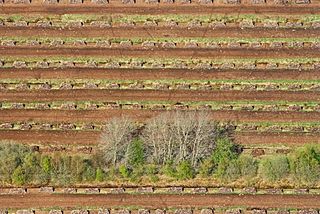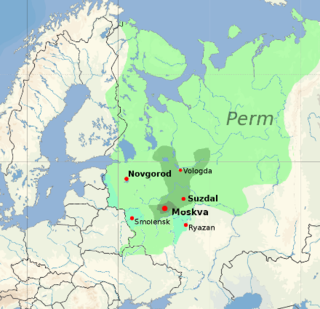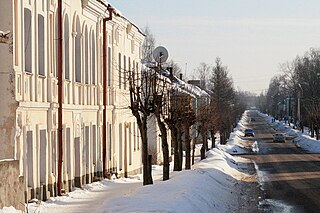
Opochka is a town and the administrative center of Opochetsky District in Pskov Oblast, Russia, located on the Velikaya River, 130 kilometers (81 mi) south of Pskov, the administrative center of the oblast. Population: 11,603 (2010 Census); 13,964 (2002 Census); 16,190 (1989 Census).
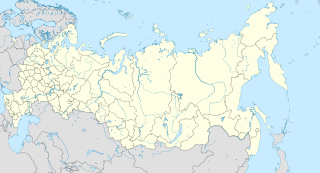
Ostrov is a town and the administrative center of Ostrovsky District in Pskov Oblast, Russia, located on the Velikaya River, 55 kilometers (34 mi) south of Pskov, the administrative center of the oblast. Population: 21,668 (2010 Census); 25,078 (2002 Census); 29,060 (1989 Census); 27,000 (1974).

Dno is a town and the administrative center of Dnovsky District in Pskov Oblast, Russia, located at the intersection of the Pskov–Bologoye and St. Petersburg–Kiev railways, 113 kilometers (70 mi) east of Pskov, the administrative center of the oblast. Population: 9,061 (2010 Census); 10,049 (2002 Census); 12,406 (1989 Census).

Novorzhev is a town and the administrative center of Novorzhevsky District in Pskov Oblast, Russia, located on the Sorot River 144 kilometers (89 mi) southeast of Pskov, the administrative center of the oblast. Population: 3,695 (2010 Census); 4,125 (2002 Census); 5,050 (1989 Census).

Strugi Krasnye is an urban locality and the administrative center of Strugo-Krasnensky District of Pskov Oblast, Russia, located 87 kilometers (54 mi) northeast of Pskov. Municipally, it is incorporated as Strugi Krasnye Urban Settlement, the only urban settlement in the district. Population: 8,447 (2010 Census); 8,762 (2002 Census); 7,067 (1989 Census).

Bezhanitsy is an urban locality and the administrative center of Bezhanitsky District of Pskov Oblast, Russia. It is one of the two urban-type settlements in the district. Population: 4,333 (2010 Census); 4,846 (2002 Census); 6,789 (1989 Census).
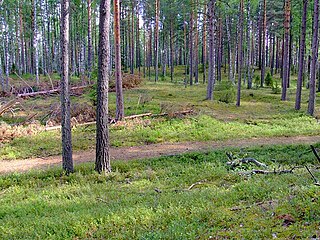
Bezhanitsky District is an administrative and municipal district (raion), one of the twenty-four in Pskov Oblast, Russia. It is located in the central and eastern parts of the oblast and borders with Dedovichsky District in the north, Poddorsky and Kholmsky Districts of Novgorod Oblast in the east, Loknyansky District in the south, Novosokolnichesky, Pustoshkinsky, and Opochetsky Districts in the southwest, and with Novorzhevsky District in the west. The area of the district is 3,535 square kilometers (1,365 sq mi). Its administrative center is the urban locality of Bezhanitsy. Population: 13,264 (2010 Census); 17,547 ; 22,784 (1989 Census). The population of Bezhanitsy accounts for 32.7% of the district's total population.

Dedovichsky District is an administrative and municipal district (raion), one of the twenty-four in Pskov Oblast, Russia. It is located in the east of the oblast and borders with Dnovsky District in the north, Volotovsky District of Novgorod Oblast in the northeast, Poddorsky District, also of Novgorod Oblast, in the east, Bezhanitsky District in the south, Novorzhevsky District in the southwest, and with Porkhovsky District in the west. The area of the district is 2,188 square kilometers (845 sq mi). Its administrative center is the urban locality of Dedovichi. Population: 14,692 (2010 Census); 17,881 ; 18,948 (1989 Census). The population of Dedovichi accounts for 59.9% of the district's total population.

Krasnogorodsky District is an administrative and municipal district (raion), one of the twenty-four in Pskov Oblast, Russia. It is located in the west of the oblast and borders with Ostrovsky District in the north, Pushkinogorsky District in the northeast, Opochetsky District in the southeast, Sebezhsky District in the south, Cibla and Kārsava municipalities of Latvia in the southwest, and with Pytalovsky District in the west. The area of the district is 1,320.42 square kilometers (509.82 sq mi). Its administrative center is the urban locality of Krasnogorodsk. Population: 7,328 (2010 Census); 9,800 ; 11,886 (1989 Census). The population of Krasnogorodsk accounts for 52.8% of the district's total population.

Loknyansky District is an administrative and municipal district (raion), one of the twenty-four in Pskov Oblast, Russia. It is located in the east of the oblast and borders with Kholmsky District of Novgorod Oblast in the northeast, Toropetsky District of Tver Oblast in the southeast, Velikoluksky District in the south, Novosokolnichesky District in the southwest, and with Bezhanitsky District in the northwest. The area of the district is 2,412 square kilometers (931 sq mi). Its administrative center is the urban locality of Loknya. Population: 9,535 (2010 Census); 13,268 ; 16,782 (1989 Census). The population of Loknya accounts for 40.6% of the district's total population.

Novorzhevsky District is an administrative and municipal district (raion), one of the twenty-four in Pskov Oblast, Russia. It is located in the center of the oblast and borders with Porkhovsky District in the north, Dedovichsky District in the northeast, Bezhanitsky District in the east, Opochetsky District in the south, Pushkinogorsky District in the west, and with Ostrovsky District in the northwest. The area of the district is 1,683 square kilometers (650 sq mi). Its administrative center is the town of Novorzhev. Population: 9,334 (2010 Census); 12,217 ; 15,477 (1989 Census). The population of Novorzhev accounts for 39.6% of the district's total population.

Novosokolnichesky District is an administrative and municipal district (raion), one of the twenty-four in Pskov Oblast, Russia. It is located in the south of the oblast and borders with Loknyansky District in the north, Velikoluksky District in the east, Nevelsky District in the south, Pustoshkinsky District in the west, and with Bezhanitsky District in the northwest. The area of the district is 1,616.0 square kilometers (623.9 sq mi). Its administrative center is the town of Novosokolniki. Population: 14,776 (2010 Census); 19,389 ; 21,319 (1989 Census). The population of Novosokolniki accounts for 54.9% of the district's total population.

Opochetsky District is an administrative and municipal district (raion), one of the twenty-four in Pskov Oblast, Russia. It is located in the southwest of the oblast and borders with Pushkinogorsky District in the north, Novorzhevsky District in the northeast, Bezhanitsky District in the east, Pustoshkinsky District in the southeast, Sebezhsky District in the south, and with Krasnogorodsky District in the west. The area of the district is 2,028.9 square kilometers (783.4 sq mi). Its administrative center is the town of Opochka. Population: 18,673 (2010 Census); 23,973 ; 28,877 (1989 Census). The population of Opochka accounts for 62.1% of the district's total population.

Ostrovsky District is an administrative and municipal district (raion), one of the twenty-four in Pskov Oblast, Russia. It is located in the west of the oblast and borders with Pskovsky District in the north, Porkhovsky District in the northeast, Novorzhevsky District in the southeast, Pushkinogorsky and Krasnogorodsky Districts in the south, Pytalovsky District in the west, and with Palkinsky District in the northwest. The area of the district is 2,400 square kilometers (930 sq mi). Its administrative center is the town of Ostrov. Population: 31,096 (2010 Census); 36,685 ; 14,199 (1989 Census). The population of Ostrov accounts for 69.7% of the district's total population.

Palkinsky District is an administrative and municipal district (raion), one of the twenty-four in Pskov Oblast, Russia. It is located in the west of the oblast and borders with Pskovsky District in the northwest, Ostrovsky District in the southeast, Pytalovsky District in the south, Viļaka and Alūksne Municipalities of Latvia in the southwest, and with Pechorsky District in the northwest. The area of the district is 1,191.2 square kilometers (459.9 sq mi). Its administrative center is the urban locality of Palkino. Population: 8,826 (2010 Census); 10,520 ; 12,392 (1989 Census). The population of Palkino accounts for 33.1% of the district's total population.
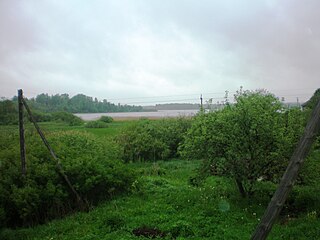
Pustoshkinsky District is an administrative and municipal district (raion), one of the twenty-four in Pskov Oblast, Russia. It is located in the south of the oblast and borders with Bezhanitsky District in the north, Novosokolnichesky District in the east, Nevelsky District in the south, Sebezhsky District in the west, and with Opochetsky District in the northwest. The area of the district is 1,870 square kilometers (720 sq mi). Its administrative center is the town of Pustoshka. Population: 9,379 (2010 Census); 12,071 ; 14,063 (1989 Census). The population of Pustoshka accounts for 49.2% of the district's total population.
Sebezhsky District is an administrative and municipal district (raion), one of the twenty-four in Pskov Oblast, Russia. It is located in the southwest of the oblast and borders with Rasony and Verkhnyadzvinsk Districts of Vitebsk Oblast of Belarus in the south, Zilupe, Ludza, and Cibla municipalities of Latvia in the west, Krasnogorodsky and Opochetsky Districts in the north, and with Pustoshkinsky and Nevelsky Districts in the east. The area of the district is 3,100 square kilometers (1,200 sq mi). Its administrative center is the town of Sebezh. Population: 21,674 (2010 Census); 25,473 ; 26,926 (1989 Census). The population of Sebezh accounts for 29.4% of the district's total population.

Velikoluksky District is an administrative and municipal district (raion), one of the twenty-four in Pskov Oblast, Russia. It is located in the southeast of the oblast and borders with Loknyansky District in the north, Toropetsky District of Tver Oblast in the northeast, Kunyinsky District in the east, Usvyatsky District in the south, Nevelsky District in the southwest, and with Novosokolnichesky District in the west. The area of the district is 2,960 square kilometers (1,140 sq mi). Its administrative center is the town of Velikiye Luki. Population: 22,121 (2010 Census); 24,035 ; 31,911 (1989 Census).

Krasnogorodsk is an urban locality and the administrative center of Krasnogorodsky District of Pskov Oblast, Russia, located on the Sinyaya River south of Pskov. Municipally, it is incorporated as Krasnogorodsk Urban Settlement, the only urban settlement in the district. Population: 3,870 (2010 Census); 4,694 (2002 Census); 5,295 (1989 Census).

Pushkinskiye Gory is an urban locality and the administrative center of Pushkinogorsky District of Pskov Oblast, Russia. Municipally, it is incorporated as Pushkinogorye Urban Settlement, the only urban settlement in the district. Population: 5,222 (2010 Census); 6,089 (2002 Census); 7,067 (1989 Census).







